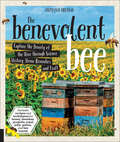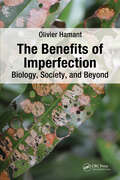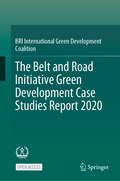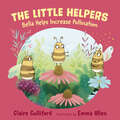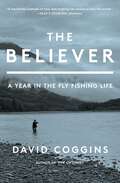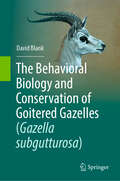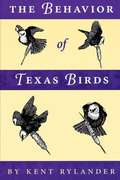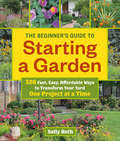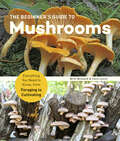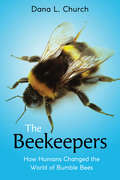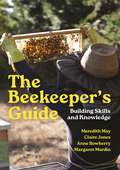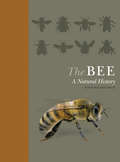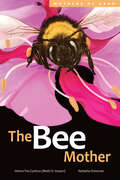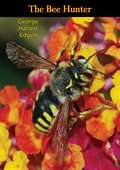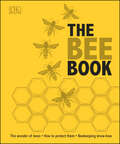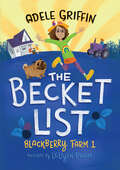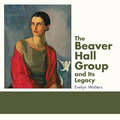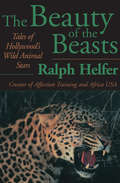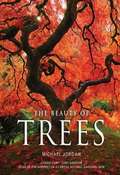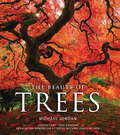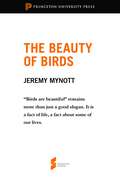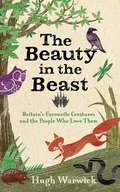- Table View
- List View
The Benevolent Bee: Capture the Bounty of the Hive through Science, History, Home Remedies, and Craft
by Stephanie BruneauA beekeeper and herbalist shares how you can use six products of the beehive: honey, pollen, propolis, royal jelly, beeswax, and bee venom. Not all new beekeepers realize that a honeybee hive produces a lot more than just honey. While your hard-working ladies will produce delicious honey, the hive as a whole also produces pollen, propolis, royal jelly, beeswax, and bee venom; all very useful things for humans, if we know how to use them.The Benevolent Bee describes how and why the bees make these products, how they&’ve been used by humans throughout the ages, and how beekeepers can harvest the products. It also presents simple do-it yourself recipes for using the products in health and wellness, body care, nutrition, and craft. You'll learn how to make salves for burns and a cough syrup from raw honey; how to make a tincture, an infused oil, and a mouthwash from propolis, the anti-bacterial &“bee glue&” that lines the inside of the hive; and much more. Get crafting now, it&’s all already in your hive!
The Benefits of Imperfection: Biology, Society, and Beyond
by Olivier HamantThe cult of performance leads our society to emphasise the values of success and continuous optimisation in all areas. Slowness, redundancy and randomness are therefore negatively perceived. Olivier Hamant, in his book, reclaims them by his knowledge of biological processes.What can we learn from life sciences? While some biological mechanisms certainly boast formidable efficiency, recent advances instead highlight the fundamental role of errors, incoherence or slowness in the robustness of living organisms. Should life be considered suboptimal? To what extent could suboptimality become a counter-model to the credo of performance and control in the Anthropocene?In the face of pessimistic observations and environmental alerts, the author outlines solutions for a future that is viable and reconciled with nature.Key Features: Solidly documents with a grounding in scientific facts focusing on solutions Explores a pragmatic way towards robustness, moving the debate beyond performance, technolatry or degrowth Responds to eco-anxiety by providing an engaging and viable way forward
The Belt and Road Initiative Green Development Case Studies Report 2020
by BRI International Green DevelopmentThis is an Open Access book. In accordance with the 2030 Agenda for Sustainable Development, it showcases 17 projects under the framework of Belt & Road Initiative (BRI). These projects cover ninefields, namely, biodiversity and ecosystem, clean energy, clean water, sustainable transportation, solid waste treatment, sustainable consumption and production, green buildings, sustainable foodproduction and corporate social responsibility. Aiming at achieving green development, these projects, in their implementation, adhere to the concept of ecological civilization, combine China’s strict environmental protection systems and international standards, and take various measures of environmental protection based on the conditions of the local environment. These measures include joint efforts with local governments, businesses and communities, optimizating of design and construction plans, strict controling over different types of pollutants, and in situ conservation of species and ecosystems.The experience and practice of these 13 projects set an example for the latecomers.
The Bella Helps Increase Pollination: (a climate-conscious children's book) (The Little Helpers)
by Claire Culliford Emma AllenA new series of climate-conscious children's books.Bella is a bee. Bella’s grandma, Bonnie, is a queen bee. Bella notices there aren’t as many flowers in the garden as there used to be and the ones which are there are dry and wrinkled containing very little nectar. How can Bella help the flowers grow? What can she do to make more honey?Bella Helps Increase Pollination is part of the Little Helpers series, written to support the United Nations’ Sustainable Development Goals. With fantastic, colourful animal characters, the stories show children how helping each other and their environment can be lots of fun!PRAISE FOR THE LITTLE HELPERS SERIES“Engaging and educational” People's Trust for Endangered Species“Wonderful” Peter Hylands, President, Australian Wildlife Protection Council“Truthful and inspiring” Emma Girvan, PR and Communications, The Australian Koala Foundation“Beautiful” Anne Rowberry, Chair of The British Beekeepers Association“Educates and inspires” Iglika Trifonova, Chair of APECS Bulgaria“Fun and engaging” Jason McCartney, MP for Colne Valley“Really engage[s] children and provide[s] a platform for them to explore some really big questions” Debbie Kelly, Principal, Beaumont Park Academy“We love Claire’s characters” Rufus Bellamy, Manager, David Bellamy Conservation Award Scheme“Fun and accessible” Joe Eisen, Executive Director of the Rainforest Foundation UKTHE LITTLE HELPERS SERIESHector Helps Clean up the ParkPenny Helps Protect the Polar Ice CapsTyler Helps Find a New HomePaula Helps Prevent Air PollutionKati Helps Avoid HungerBella Helps Increase PollinationEddie Helps Locate WaterPan Pan Helps Shelter From Acid Rain
The Believer: A Year in the Fly Fishing Life
by David CogginsThe author of the instant fishing classic The Optimist shares new wisdom, humor, and experience in seven extraordinary fly-fishing expeditions—&“an engaging personal journey about finding what you need to find and keeping it in your heart&” (Kirkus Reviews).In The Optimist, David Coggins tackled the techniques of fly-fishing and meditated on its virtues, recounting his triumphs and failures. Now, in The Believer, he deftly mixes travel, local cultures, further fishing challenges (some knee-buckling in their disappointment), and details his own experience as life and love crowd his time to fish. Self-consciously—and self-deprecatingly—Coggins embarks on seven far-flung fishing voyages, away from screens and social media, not answering his phone, and reveling in humanity&’s undying yearning for a quest, for the rituals and rites of passage that mark transition. For Coggins, these journeys—to Norway, Scotland, Spain, Cuba, and Argentina, as well as road trips to Wyoming, Tennessee, and the Catskills—not only showcase his skill as an angler but also signal the end of his fly-fishing youth. But that doesn&’t mean that Coggins will sell all his rods and hang up his hat; rather, his relationship with his fly-fishing obsession will evolve—especially if he can catch an elusive salmon or a ferociously strong tarpon or the mercurial permit. The Believer is a humble, humorous call for the journey that is as enriching as the destination, where the search for greater self-awareness leads to patience, observation, and endurance. And, since this is fly-fishing, after all, there&’s always the possibility of abject failure and leaping, glorious reward. Wry, entertaining, thoughtful, and relatable, The Believer is &“a wonderful example of how well angling can weave us into the world&” (Gray&’s Sporting Journal) and will hook both anglers and non-anglers alike.
The Behavioral Biology and Conservation of Goitered Gazelles (Gazella subgutturosa)
by David BlankThis comprehensive and lavishly illustrated book summarizes all known information on the Goitered Gazelle (Gazella subgutturosa), one of the world's most endangered antelopes. It includes information on topics such as feeding ecology, behavior, vocalizations, parasites and diseases, and conservation. This research monograph will be of interest to professional researchers of ungulates, university staff, students, and naturalists.
The Behavior of Texas Birds
by Kent RylanderWhether it's the sudden, plunging dives of Brown Pelicans, the singing and aerial displays of Northern Mockingbirds, or the communal nesting of Purple Martins, innate and learned behaviours are some of the most fascinating things to observe in Texas birds. Even casual birdwatchers eventually ask, ""why do they do that?"" while serious birders and ornithologists seek to understand all the behaviours involved in feeding, flying, mating, and rearing young. But until now, it has been hard to find this information in one handy source. In this comprehensive, yet easy-to-use book, Kent Rylander distils data from many sources to provide an authoritative guide to the behaviour of Texas birds. He begins by explaining the principles of animal behaviour and illustrating how they can be applied to interpreting bird behaviours in the field. The majority of the book is devoted to accounts of more than 400 species of birds that are most likely to be encountered by Texas birdwatchers. Each account describes such behaviours as feeding, courtship, parenting, and other behaviours that are significant for that species.
The Beginner's Guide to Starting a Garden: 326 Fast, Easy, Affordable Ways to Transform Your Yard One Project at a Time
by Sally RothA fresh approach and simple way to transform your yard! The prospect of revamping a yard is daunting. Where do you start? How do all the various areas come together in a beautiful, cohesive way? The Beginner’s Guide to Starting a Garden simplifies the process by showing you how to spend fewer hours (and a minimal amount of money) in the garden by tackling one small area at a time. You’ll find garden plans for ten unique areas—the entryway, the shady areas under trees, and more—that can be linked together over time to create a unified yard, and plants that are dependable, easy to find, and look good year after year. You’ll also learn the basics of good design, which plants offer the most bloom for your buck, and how to avoid the most common planting mistakes.
The Beginner's Guide to Mushrooms: Everything You Need to Know, from Foraging to Cultivating
by Britt Bunyard Tavis LynchThe Beginner&’s Guide to Mushrooms is your ultimate guide to mycology. Whether you&’ve never picked a mushroom before in your life or you&’ve been cultivating mushrooms at home for ages, the expert advice in this comprehensive mushroom manual will transform your practice. Never before have mushrooms generated so much interest, for their health benefits and medicinal properties, as well as a new understanding of their crucial role in a healthy environment and ability to regenerate damaged ones. If you are a newcomer, mycology, or the study of mushrooms and other fungi, can seem daunting. While other field guides are geared toward experts with advanced knowledge or regional in scope and aimed at only a few easy-to-recognize mushrooms, The Beginner&’s Guide to Mushrooms by veteran mycologists Britt A. Bunyard and Tavis Lynch is a complete reference and guidebook to get you started identifying, cultivating, cooking, and preserving mushrooms. The Beginner&’s Guide to Mushrooms opens with important basics about wild mushrooming and how to use the book. Information about what fungi are and their role in the environment and around the home is provided in brief and very understandable terms. Basic wild mushroom anatomy is discussed along with how to identify mushrooms and various characteristics to look for—of great importance if you are interested in learning how to recognize edible wild species…as well as dangerous look-alikes. The guide then covers: All the major groups of wild mushrooms, pointing out habitat, region, and notable characteristics—large photographs with easy-to-view characteristics facilitate correct identification. Mushroom cultivation—with easy-to-follow illustrated instructions, learn how to grow mushrooms at home, including how to collect wild specimens and domesticate them. Culinary uses and how to preserve wild mushrooms to be enjoyed in the kitchen all year round. Begin your wonderful exploration of wild mushrooms with this accessible yet thorough beginner's guide.
The Beekeepers: How Humans Changed The World Of Bumble Bees (Scholastic Focus)
by Dana L. ChurchBumble bees are as familiar to most of us as the flowers these fuzzy insects feed upon. But did you know that the bees in your garden could be escapees from a local greenhouse, or descended from stowaways on a Viking ship?Bumble bees are a vital part of our lives and Earth's ecosystems, so much so that we've commercialized their breeding and shipped them across states, countries, and ecosystems for our benefit. However, all of that human interference has consequences. Bumble bees are pushing out native species and altering ecosystems worldwide. Pesticide use has led to the spread of disease in local colonies. And some species may be disappearing entirely.The Beekeepers is an expertly researched overview of bumble bees -- from hive hierarchies to how their brains work -- and the passionate humans and scientists who are fighting for their survival. With a thoughtful and accessible voice, researcher Dana Church introduces readers to the fascinating world of bumble bees, how and why some are thriving while others are floundering, and how both experts and regular citizens are working to ensure their future. Equal parts endearing, frustrating, and hopeful, this scientific narrative is essential for readers looking to understand and make an impact on our changing world.
The Beekeeper's Guide: Building Skills and Knowledge
by Claire Jones Meredith May Anne Rowberry Margaret MurdinA comprehensive guide on establishing and maintaining beehivesBeekeeping is a popular pastime that more and more people are taking up for fun or even modest profit. Today, you will find hives not only in large fields or rural spaces, but also in city gardens and on rooftops—to the benefit of both bee and beekeeper. If you&’re at the early or middle stages of your beekeeping journey and need a go-to guide on establishing and maintaining your hives, The Beekeeper&’s Guide is the perfect companion. It offers invaluable information about a wide range of bee species and their life cycle, behavior, and optimal habitat, and covers the practicalities of beekeeping, from personal safety and hive hygiene to feeding methods and record keeping. Complete with an extensive troubleshooting section and a directory of useful resources, The Beekeeper&’s Guide is a comprehensive tool for all beekeepers.
The Bee: A Natural History
by Noah Wilson-Rich Kelly Allin Norman Carreck Andrea QuigleyBees pollinate more than 130 fruit, vegetable, and seed crops that we rely on to survive. Bees are crucial to the reproduction and diversity of flowering plants, and the economic contributions of these irreplaceable insects measure in the tens of billions of dollars each year. Yet bees are dying at an alarming rate, threatening food supplies and ecosystems around the world. In this richly illustrated natural history of the bee, Noah Wilson-Rich and his team of bee experts provide a window into the vitally important role that bees play in the life of our planet. Earth is home to more than 20,000 bee species, from fluorescent-colored orchid bees and sweat bees to flower-nesting squash bees and leaf-cutter bees. This book takes an incomparable look at this astounding diversity, blending an engaging narrative with practical, hands-on discussions of such topics as beekeeping and bee health. It explores our relationship with the bee over evolutionary time, delving into how it came to be, where it stands today, and what the future holds for humanity and bees alike. Provides an accessible, illustrated look at the human-bee relationship over time Features a section on beekeeping and handy go-to guides to the identification, prevention, and treatment of honey bee diseases Covers bee evolution, ecology, genetics, and physiology Includes a directory of notable bee species Presents a holistic approach to bee health, including organic and integrated pest management techniques Shows what you can do to help bee populations
The Bee Mother (Mothers of Xsan)
by Hetxw’ms Gyetxw HusonLearn about the life cycles of different kinds of bees in this enlightening picture book. As flowers and trees begin to bud and bloom, Nox Ap, the bee mother, emerges from her winter sleep. To the Gitxsan, she is nature&’s gardener. Without her hard work as a pollinator, we could not enjoy the fruits of strawberries and huckleberries. Follow her life from the first thaw of spring to the end of autumn. In the seventh book of Hetxw'ms Gyetxw (Brett D. Huson)&’s Mothers of Xsan series, readers will discover the important role of the bumblebee, the honeybee, and the yellow jacket wasp in the Xsan ecosystem.
The Bee Hunter
by George Harold EdgellOriginally published in 1949, this amusing and informative little book gives a charming account of an avocation seriously pursued by the author for fifty summers. It provides as well, with clarity and wit, a manual for lovers of nature (and wild honey) who might wish to undertake this ingenious sport. George Harold Edgell sticks his neck out on the first page and says no other book describing the proper approach to wild bees exists. “It is time,” he says, “for someone who has hunted bees and found bee trees to write the facts.”
The Bee Book: Discover the Wonder of Bees and How to Protect Them for Generations to Come
by DKThe Bee Book shows you step-by-step how to create a bee-friendly garden, get started in beekeeping, and harness the power of honey for well-being.Fully illustrated with full-color photographs throughout, this beautiful guide covers everything you need to know to start your own backyard hive, from setup to harvest. Practical beekeeping techniques are explained with clear step-by-step sequences, photos, and diagrams so you'll be prepared to establish your own colony, deal with diseases, collect a swarm, and much more.A comprehensive gardening chapter features planting plans to fill container and border gardens, bee "hotel" and habitat projects, and an at-a-glance flower gallery of bees' favorite plants. The Bee Book also shows you how to harvest honey, beeswax, and propolis from the hive and use these ingredients in 38 recipes for home remedies, beauty treatments, and candle-making.Discover the wonder of bees in nature, in your garden, and in the hive with The Bee Book, lavishly bound in a beautiful gold-foil and texture cover and perfect for gift giving.
The Bee Book (Conservation for Kids)
by Charlotte MilnerDiscover more about our fuzzy little insect friends with award-winning author and illustrator Charlotte Milner. The perfect introduction to bee conservation for little ones. Learn all about the beautiful world of bees and their adventure from flower to flower. You'll find out just how much they matter, why they are declining, and what we can do to help in this adorable kids' ebook. Bees are brilliant at building, super social creatures and along with other insects, are responsible for a third of every mouthful of food you eat! Children will be fascinated by the beautiful pictures and learn plenty of buzz-worthy fun facts in every chapter, covering types of bees, beehives, beekeeping, how they pollinate plants and make honey.A beautiful kid&’s educational ebook about bees with a crucial message: not only does it inform and educate about an issue that is a real threat, but it also delivers it in a way that is gripping for all ages. A dazzling celebration of bees, packaged in a gorgeous ebook with spectacular illustrations.What&’s The Buzz About Honey Bees?Meet the humble honeybee face-to-face - an animal that is considered nature's hardest worker, in this engaging, educational kids&’ ebook that you can treasure forever.What do they do all day? Why are bees important? Find out why they need our help and what you can do. Bees are responsible for so much more than making honey. This ebook is an essential tool in encouraging the protection of our precious buzzing friends for generations to come.Learn all about these valuable creatures:- What happens in the hive- What pollination is- Who the queen is- How honeybees talk to each other- How we can help them and much, much more!This adorable book is one of three children's books on conservation by award-winning author Charlotte Milner and includes The Sea Book and The Bat Book for your little ones to enjoy.
The Becket List: A Blackberry Farm Story
by Adele GriffinAdventure and discover with the bold and intrepid Becket Branch when her family’s move from city to a country farm means big changes! Everything is changing for Becket Branch. From subways to sidewalks to safety rules, Becket is a city kid born and raised. Now the Branch family is trading urban bustle for big green fields and moving to Gran’s farm, where Becket has to make sense of new routines from feeding animals to baling hay. And as much as Becket loves to yell “Beautiful Alert!” there’s a lot about the countryside that is just plain odd. But Becket is ready to put her own spin on country life. Whether selling her mouth-puckering lemonade, feeding hostile hens, or trying to make a best friend of her new neighbor Frieda Franca, Becket is determined to use her city smarts to get a grip on farm living. Laugh and learn with Becket as she mucks through the messy, exuberant human experience of change she didn’t ask for, in a story that sparkles with quirky characters and lasting connections.
The Beaver Hall Group and Its Legacy
by Evelyn WaltersAn exploration into Montreal’s Beaver Hall Group and its legacy of women painters who now rank among Canada’s most outstanding artists. Today it is difficult to imagine that the art of Montreal’s Beaver Hall Group was once shocking. As these Modernists struggled against academic art, critics such as Samuel Morgan-Powell ranted — “rough,” “meaningless” “blatant plastering and massing of unpleasant colours in weird landscapes” — and likened their paintings to the “cacophonous riot of metallic yowlings” of jazz that was invading the city. Moreover, unlike their contemporaries, the Group of Seven, the Beaver Hall Group dared to break with tradition and accept women members. The result was a legacy of some of the finest women painters Canada has so far produced. In 2005, Evelyn Walters gave them deserved attention in her acclaimed book, The Women of Beaver Hall: Canadian Modernist Painters. Now, a follow-up, The Beaver Hall Group and Its Legacy delves into the engrossing life stories of the twenty-five artists who belonged to the Beaver Hall Group and the Women of Beaver Hall. Over seventy-five images gleaned from museums and private collections highlight the work of these pioneering artists who changed the course of Canadian art. Written for student and scholar alike, The Beaver Hall Group and Its Legacy is a must for every art lover’s library.
The Beaver Hall Group 2-Book Bundle: The Women of Beaver Hall / The Beaver Hall Group and Its Legacy
by Evelyn WaltersFrom the vanguard of Modernism in Montreal, the Beaver Hall Group included painters who are now ranked among Canada's most distinguished artists. Evelyn Walters brings her extensive knowledge of the group to paint a picture of the artists' lives and their works in this two-book bundle. More than 130 reproductions bring to light paintings that have lain hidden for more than fifty years. Includes: The Beaver Hall Group and Its Legacy The Women of Beaver Hall
The Beauty of the Beasts: Tales of Hollywood's Wild Animal Stars
by Ralph HelferA trainer shares true stories of famous lion, orangutan, and other animal actors that &“will hold readers enthralled&” (School Library Journal). They are major stars who do not speak a word onscreen, yet are world famous for their compelling performances. Who are they? The animal stars of the big screen, of course! In The Beauty of the Beasts, Ralph Helfer shares with the reader his love of animals and his work with some of Hollywood&’s biggest stars: Clarence the Cross‑Eyed Lion, Gentle Ben, the Schlitz Malt Liquor Bull, Clint Eastwood&’s orangutan sidekick Clyde, and many more. Helfer shares his philosophy on training these beautiful beasts to do amazing feats and maximize their acting potential without coercion. Join Ralph Helfer in his exploration of animal acting and read of his masterful use of TLC to work with these phenomenal, non‑human actors.
The Beauty of Trees
by Michael JordanThis illustrated tour of the world's most extraordinary trees provides an insight into some of the natural world's most astonishing structures. Through 100 photographs, The Beauty of Trees tells the story of our relationship with trees throughout history.Each image is supported by information about the botany of the tree, along with the stories, traditions and legends associated with it. From the giant sequoias of California to the bonsai of Japan, the pink tulip tree of the Himalayas to the Scots pine--and even the humble acorn--award-standard photography and insightful text bring the majesty and mystery of the world's trees to life.
The Beauty of Trees
by Michael JordanThis illustrated tour of the world's most extraordinary trees provides an insight into some of the natural world's most astonishing structures. Through 100 photographs, The Beauty of Trees tells the story of our relationship with trees throughout history. Each image is supported by information about the botany of the tree, along with the stories, traditions and legends associated with it. From the giant sequoias of California to the bonsai of Japan, the pink tulip tree of the Himalayas to the Scots pine - and even the humble acorn - award-standard photography and insightful text bring the majesty and mystery of the world's trees to life.
The Beauty of Trees
by Michael JordanThis illustrated tour of the world's most extraordinary trees provides an insight into some of the natural world's most astonishing structures. Through 100 photographs, The Beauty of Trees tells the story of our relationship with trees throughout history. Each image is supported by information about the botany of the tree, along with the stories, traditions and legends associated with it. From the giant sequoias of California to the bonsai of Japan, the pink tulip tree of the Himalayas to the Scots pine - and even the humble acorn - award-standard photography and insightful text bring the majesty and mystery of the world's trees to life.
The Beauty of Birds: From Birdscapes: Birds in Our Imagination and Experience (Princeton Shorts #10)
by Jeremy MynottSpring returns and with it the birds. But it also brings throngs of birders who emerge, binoculars in hand, to catch a glimpse of a rare or previously unseen species or to simply lay eyes on a particularly fine specimen of a familiar type. In a delightful meditation that unexpectedly ranges from the Volga Delta to Central Park and from Charles Dickens's Hard Times to a 1940s London burlesque show, Jeremy Mynott ponders what makes birds so beautiful and alluring to so many people. Princeton Shorts are brief selections taken from influential Princeton University Press books and produced exclusively in ebook format. Providing unmatched insight into important contemporary issues or timeless passages from classic works of the past, Princeton Shorts enable you to be an instant expert in a world where information is everywhere but quality is at a premium.
The Beauty in the Beast: Britain's Favourite Creatures and the People Who Love Them
by Hugh WarwickA delightful portrait of some of the UK's best-loved wild animals and birds and the colourful enthusiasts who champion their causes.
